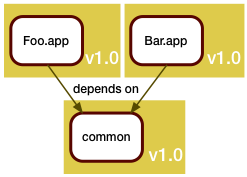
Moving right along (see parts one and two), we were using a simple system with two entry points and one piece of shared code.
We represent the state using a build manifest, expressed as a JSON file:
{ "Name": "January Release",
"Includes: [{ "Name": "Foo.app",
"Rev": "v1.0",
"Includes": [{ "Name": "common",
"Rev": "v1.0" }]},
{ "Name": "Bar.app",
"Rev": "v1.0",
"Includes": [{ "Name": "common",
"Rev": "v1.0" }]}]}
After some work, both the Foo team and the Bar team made some independent modifications, each of which made their end happy.
Since we're always in a hurry to release, we defer merging the common code, and release what we have instead. Now we would like to know what changed since the initial state.
First, we construct our new build manifest:
{ "Name": "January Release",In the previous post of the series, we cheated by only modifying one endpoint at a time, and leaving the other one unchanged. Now we change both, and it turns out the answer depends on how you ask the question:
"Includes: [{ "Name": "Foo.app",
"Rev": "v2.0",
"Includes": [{ "Name": "common",
"Rev": "v2.0" }]},
{ "Name": "Bar.app",
"Rev": "v1.1",
"Includes": [{ "Name": "common",
"Rev": "v1.1" }]}]}
Bar.app: git log ^v1.0 v1.1 # in Bar.app
git log ^v1.0 v1.1 # in common
Foo.app: git log ^v1.0 v2.0 # in Foo.app
git log ^v1.0 v2.0 # in common
whole: git log ^v1.0 v1.1 # in Bar.appWhy bring this up? Well, in the previous post I made an argument that it is not only convenient, but necessary to combine the start points of the revision ranges used to get the changes. The same is not true for the end points, as we cannot by any means claim that v2.0 of common is actually in use by Bar.app.
git log ^v1.0 v2.0 # in Foo.app
git log ^v1.0 v1.1 v2.0 # in common
So, in order to preserve the ability to answer the question "what changed only in Bar.app", as opposed to the whole system, we need to keep the log output separate for each endpoint.
Now we are pretty close to an actual algorithm to compare two build manifests:
- Traverse the old manifest and register the start points for every repo
- Traverse the new manifest and register the end points for every repo, and which entry point uses the end points.
- Traverse all registered repos, and for every registered endpoint, run:
git log ^startpoint1 ^startpoint2 ... endpoint
and register the commits and the entry points to which they belong.

No comments:
Post a Comment
Note: Only a member of this blog may post a comment.